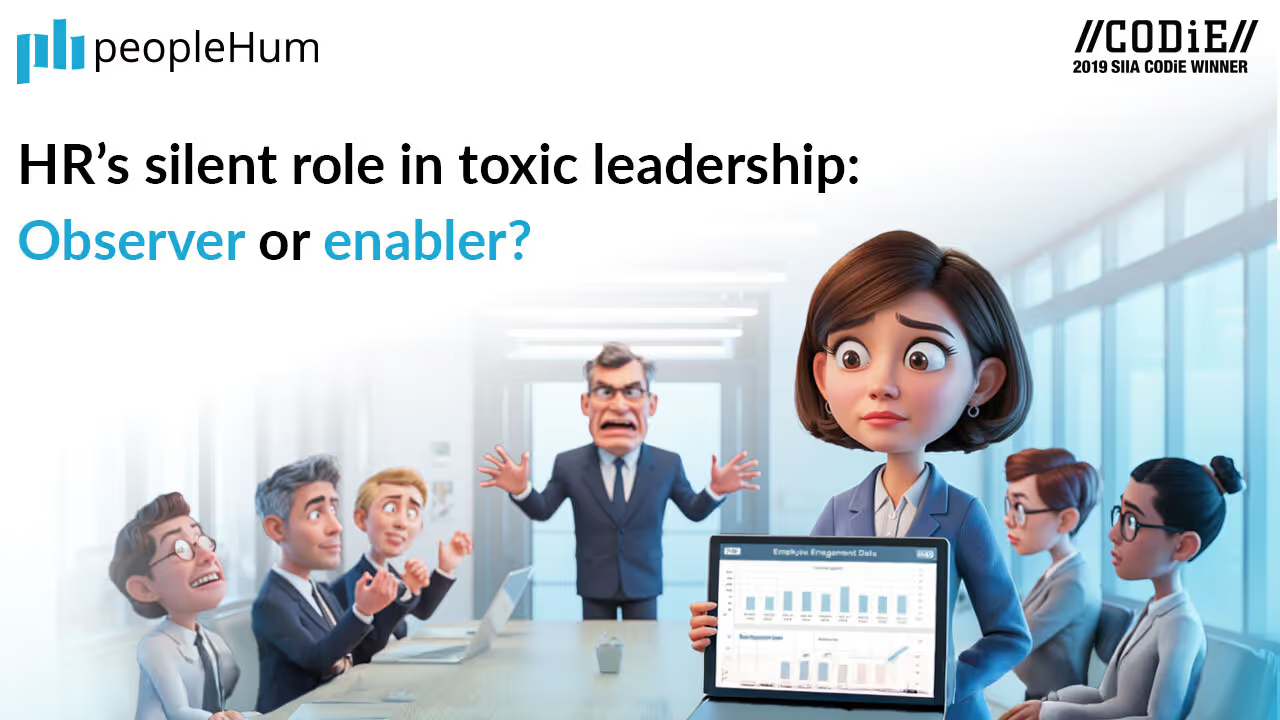Ever walked into a meeting feeling like you’re losing your grip on reality? not because of the endless PowerPoint slides, but because someone’s making you question your own memory, skills, or sanity? That’s the dark art of workplace gaslighting. It’s not just a buzzword, it’s a real problem that’s probably happening in your office right now.
This isn’t about being “too sensitive” or “misunderstanding” someone’s intentions. Gaslighting is a direct tactic to mess with your head, and it’s more common than you’d like to think.
What is gaslighting, anyway?
Gaslighting is psychological manipulation where someone makes you doubt your own reality. It’s not just lying, it’s a systematic effort to make you feel like you’re going crazy.
It is sneaky, subtle. It’s different from regular bullying, which is loud and obvious. and way more dangerous because it chips away at your confidence bit by bit. It's ideath by a thousand paper cuts, except the cuts are to your self-esteem.
Why should HR care? Because gaslighting doesn’t just hurt the person on the receiving end, it poisons the whole workplace. And HRs are the ones who can stop it.
How common is this?
It is a big deal. While exact numbers are tricky because who’s going to admit they’re being gaslit, research suggests it’s alarmingly common.
- A study in Frontiers in Psychology developed a tool to measure workplace gaslighting and found it’s tied to things like role conflict and low job satisfaction.
- A source claims that half of the workers aged 18-54 have experienced it at some point. Whether that’s spot-on or not,
The point is clear: gaslighting is everywhere.
Nobody needs a spreadsheet to see it, gaslighting is everywhere, be it through twitter, or HR forums, you'll find stories of employees who are made to feel like they’re imagining things. It’s happening in startups, corporate giants, and even those “we’re like a family” small businesses.
Here’s the kicker: Gaslighting often goes unreported because victims don’t realize what’s happening. They might think they’re the problem or fear looking “paranoid” if they speak up. That’s why HR needs to be proactive.
How to spot the red flags?
Gaslighting is hard to spot until it’s too late. But here are some obvious signs to look for:
- Denial: Someone flat-out denies something they said or did, even when you have proof. “I never told you to do that project,” they say, while your inbox shows a different view.
- Minimization: Your valid concerns are brushed off as “no big deal” or “you’re overreacting.”
- Blame-shifting: Everything’s your fault, even when it’s not. A project left on hold because the team wasn't co-ordinating? Somehow, it’s still on you.
- Isolation: You’re left out of key meetings or decisions, and when you ask why, you’re told you’re “imagining things.”
Gaslighting hurts everyone:
Gaslighting isn’t just a personal attack, it’s a workplace problem. Here’s what it does: If an employee seems confused, anxious, or like they’re questioning their own reality, don’t just chalk it up to stress. Dig deeper. It might be gaslighting.
- To employees: It’s a mental health nightmare. Victims often deal with anxiety, depression, and a crushed sense of self-worth. In extreme cases, it can lead to PTSD or long-term sick leave. It’s not just “work stress”; it’s psychological abuse.
- To the organization: High turnover, low morale, and a toxic culture are just the start. Gaslighting can also tank productivity and innovation because people are too busy second-guessing themselves to do their best work.
A workplace where gaslighting thrives is a workplace where trust dies. And without trust, you’ve got nothing.
HR’s action plan:
- Take Complaints Seriously: Don’t brush off reports as “just drama.” Gaslighting is real, and dismissing it only makes things worse.
- Encourage Documentation: Tell employees to keep a record of incidents, dates, times, what was said, who was there. This is your ammo for investigations.
- Investigate: Talk to witnesses, check emails, and get the full picture. Don’t let the gaslighter wiggle out of accountability.
- Offer Support: Gaslighting victims need more than a pep talk. Provide access to counseling, mentorship, or even a temporary reassignment if needed.
- Hold Perpetrators Accountable: If someone’s gaslighting, they need consequences,whether it’s retraining, a warning, or, in severe cases, the boot.
If you’re not sure if it’s gaslighting, ask yourself: “Would this make someone feel like they’re going nuts?” If yes, it’s probably gaslighting.
Prevention: Stop gaslighting before it starts
Why wait for a crisis? Prevent gaslighting from taking root:
- Talk openly about gaslighting: If everyone is aware what gaslighting is and how manipulative people operate, while identifying gaslighting tactics, then people gaslighting will be forewarned not too since everyone is educated on the subject
- Open Communication: Create a culture where people feel safe speaking up. No one should fear retaliation for raising a concern.
- Anonymous Feedback: Use surveys or 360-degree feedback to catch toxic behaviors early. Tools like anonymous employee feedback platforms can be a game-changer.
- Clear Policies: Have explicit rules against gaslighting and other manipulative behaviors. Make sure everyone knows them, from the CEO to the janitor.
The legal angle: Can gaslighting get you sued?
Gaslighting can contribute to a hostile work environment, which is illegal in many places. If it’s severe enough, it could lead to lawsuits for emotional distress, discrimination, or wrongful termination.
HR heads-up: If HR ignores complaints or fails to investigate, it's opening the company up to legal trouble. Document everything, follow up on reports, and show you’re taking it seriously. It’s not just about doing the right thing, it’s about covering your bases.
Wrapping it up
Gaslighting is a silent epidemic in workplaces, but it doesn’t have to be. HR professionals are the ones who can make a difference. By recognizing the signs, taking complaints seriously, and building a culture of trust, which can stop gaslighting in its tracks.Don’t wait for someone to come to you in tears. Be proactive,train your teams, set clear policies, and create a workplace where people feel valued, not manipulated.
HR can’t do it alone, but peopleHum can help:
No amount of awareness helps if your HR systems are outdated, your feedback channels are broken, and your culture is running on vibes.
That’s where peopleHum steps in. Not just another HR software. We’re the no-nonsense, no-gaslighting platform built to help you:
- Detect manipulation early with 360° feedback tools that don’t just collect praise, they surface patterns.
- Give employees a safe, structured space to speak up (not just anonymous boxes that go nowhere).
- Automate performance reviews based on actual work, not politics, bias, or verbal gymnastics.
Because a gaslighting-free workplace isn’t just a dream. It’s what happens when your tools match your talk.
Want to see how peopleHum helps HR teams shut down toxic behavior before it spreads?
👉 Book a free demo now and build a workplace that doesn’t mess with your head.
FAQs on gaslighting
1. How do I know if gaslighting is happening in my company?
Look for patterns like employees second-guessing themselves, frequent self-blame, and sudden drops in confidence or engagement. HR tools like feedback surveys can reveal early warning signs.
2. What are the most common signs of gaslighting by managers or team leads?
Repeated denial of past conversations, blaming others unfairly, withholding key information, or making employees feel “too sensitive” are all red flags to watch for.
3. How can I report or track gaslighting without employees feeling unsafe?
Use anonymous reporting systems and regular pulse checks. Platforms like peopleHum allow private feedback that HR can act on without exposing individuals.
4. Can gaslighting really impact performance and retention?
Yes, employees working under manipulation tend to disengage, stop contributing ideas, or quietly leave, costing the company time, trust, and top talent.
5. What policy should I create to stop gaslighting at the workplace?
You need a clear anti-bullying and psychological safety clause that defines gaslighting, includes examples, and explains how to report it confidentially.
6. Which HR tech tools can help identify toxic behaviors like gaslighting?
Look for platforms that offer sentiment tracking, anonymous surveys, and behavior analytics. These tools help HR catch harmful patterns before they escalate.
7. Should managers get trained to avoid unintentional gaslighting?
Yes, regular training in emotional intelligence, feedback handling, and power dynamics helps leaders communicate clearly and avoid manipulative behavior.































.avif)




.avif)













